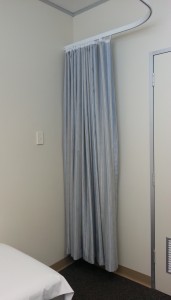THE NEED
It’s really like stating the obvious isn’t it?
Privacy is a basic right for all humans. Each person is different and what might be personal to one might not be to another. In an unfamiliar environment or when anxious, people often feel a loss of control – they feel more vulnerable.
For some, removing clothing for examinations at this time may increase their stress and leave a long lasting impression of the encounter.
HISTORY – Patient Rights
1948 saw the Universal Declaration of Human Rights – ‘the inherent dignity & rights of all members of the human family’. From this, the idea of patient rights was developed.
Since 1995 research has been conducted into Patient Dignity.
Importantly findings show that a patient’s sense of dignity can have a profound impact on their well-being and satisfaction with the healthcare system. One of the biggest factors is the way that patients are treated by their health care providers.
It was found that uncertainty about the individual’s health status & treatments can bring on enormous fear and anxiety.
INDUSTRY SUPPORT of Patient Privacy through Privacy Curtains & Blinds
The RACGP (Royal Australian College of General Practitioners) advocate the need for practice conditions to support patient privacy & confidentiality. They state – ‘Visual Privacy can be afforded to patients during the clinical examination by the use of a gown or sheet AND an adequate curtain or screen’.
Followed by, ‘Members of the clinical team need to be sensitive to patient dignity when patients are required to undress / dress in the presence of the GP or practice nurse’.
NSW Health
Specifically mention that Curtains, doors & window blinds will be closed and every effort will be made to maintain patient’s privacy & dignity.
Rebirth a Clinic – Booklet
This highlights that space is required around an examination couch, to provide room for the clinician behind the curtain.
PRIVACY TRACKS & CURTAINS
Consider carefully the position of the Track & Curtain in the Consulting room.
If the sole purpose of the Privacy Curtain is to maintain patient privacy & dignity, then there must be sufficient room behind the curtain for the client to undress & dress.
Searching on-line shows a trend towards people becoming larger, so perhaps there needs to be more room behind the Privacy Curtain then ever before?
Ideally the track should be positioned so there is ample room for the Healthcare provider to examine / treat the patient within the privacy of a drawn curtain.
Keep in mind too that the curtain is only ever around the bed whilst in use, so if it encroaches on a little bit of ‘free’space in the room, it will only be temporary. When not being used it stacks neatly to one end.
This raises a question ….
People are more aware of their rights than ever before. Just how often is an individual’s choice of a Medical Clinic and / or Practitioner directly affected by their experience of Healthcare – particularly in relation to the level of Privacy & Dignity they were offered at the practice?
References:
www.racgp.org.au/your-practice/standards/standards4thedition/physical-factors/5-1/physical-conditions-conducive-to-confidentiality-and-privacy/
www.health.nsw.gov.au
www.dignityincare.ca/en/the-model-in-detail.html
www.toolboxes.flexiblelearning.net.au/demosites/series6/602/shared/resources/director/induction/personal_care/privacy_and_dignity.htm
‘Rebirth of a Clinic’ a design guide for architecture in general practice and primary care. RMIT University, in conjunction with RACGP




